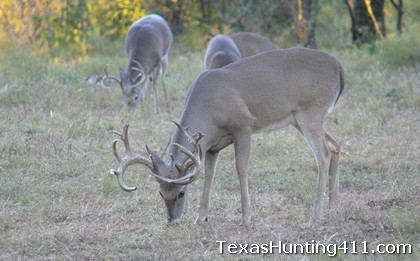Deer hunters in Texas know that it has been one a heck of a dry year, and the Hill Country has been no exception. Dry is never good for wildlife. The whitetail deer hunting forecasts have been poor, with habitat taking it on the chin. What else is there to say after drought, a lack of forb production, no fawn cover, below average antler growth and no rainfall since last September. It’s a grim deer hunting forecast if you look at just range and habitat conditions. However, there’s more to a deer season than just the habitat and game conditions.
Deer biologists always talk about buck antler development as a three-legged stool, with each leg being genetics, nutrition and age. Genetics is beyond the scope of a deer hunting forecast. In fact, genetics are the hardest factor to delineate across a ranch or area. Deer nutrition gets more press from year to year because changes in rainfall are so visible, as they certainly have been for the last 12 months. With most of Texas in an exceptional drought, all plants and animals are stressed. Nutrition has been poor.

But what about age? This third leg of the stool is often overlooked by the nearsighted. With bobwhite quail, hunters looks to the current year’s hatch to determine quail hunting prospects. Not so with whitetail deer. A whitetail’s body is considered mature at 4 1/2 years of age, but antlers continue to increase until about 6 1/2. Habitat conditions at birth also factor in to future body and antler development.
Texas Parks and Wildlife Department (TPWD) biologist David Veale points out that the 2007 South Texas fawn crop was an excellent one, and got off to a healthy start in life. Out of a large class, more animals will survive. Those that did are 4 1/2 years old this year. Look back at last season, too. Because of excellent range conditions, deer did not have to move around to find food. The deer harvest was lower than usual. More carryover.
The deer hunting forecast compiled for the Hill Country quotes TPWD Derrick Wolter saying, “A lot of deer did not get shot, and there should be some nice, older bucks in the mix.” Deer hunting in the Texas Hill Country looks a lot better when hunters consider the fact that there are a lot of older bucks in the herd. Less buck harvest in the past means more mature bucks will be shot in the future.
In the Trans-Pecos, biologist Jason Wagner speaks of hunters reporting seeing many 4 1/2 to 5 1/2 year old bucks last season. In Northern Central Texas, James Edwards as said of last season, “Fewer young bucks are being reported in the harvest. Landowners have seen better quality deer over the entire area.” Deer management is helping. David Sierra reports that in the post oak region of East Texas, antler restrictions are bringing more older bucks into the harvest. The younger bucks that were allowed to walk last year are a year older now.
There can be no disputing that body conditions and antlers will be below average this year, and the Texas Hill Country is no exception. As Charlie Newberry in Henrietta and Ralph Suarez in Ballinger and practically every other contributing wildlife biologist mentions, habitat conditions could be a lot better. It’s a statewide thing. Current range conditions, however, when coupled with the low harvest of a large age class of deer, indicates that there could be a lot of 4 1/2 year old bucks out there looking for something to eat this season. Deer hunting will be good, but the deer themselves may not fair as well.